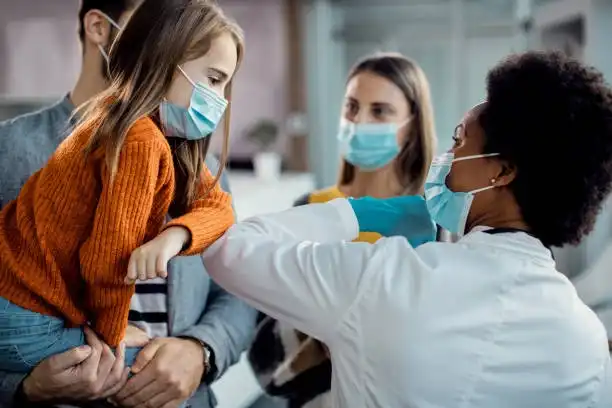Blood clots can also form in veins that are closer to the skin, known as superficial venous thrombosis, and cause a syndrome called superficial thrombophlebitis.
What Does a Blood Clot Look and Feel Like? With Pictures
A blood clot may cause swelling or pain in a leg, arm, or another area, but it doesn’t always. Here, learn how to recognize signs of a blood clot and what you should do if you experience them.
Blood clots are a serious issue, as they can be life threatening. Also called thrombosis, this condition occurs when clots form in the vessels that contain blood, preventing it from flowing effectively.
Blood clots can form in the veins or arteries. When a blood clot occurs in one of your veins, it’s called venous thromboembolism (VTE).
According to the Centers for Disease Control and Prevention (CDC), an estimated 900,000 people in the United States are affected by blood clots each year. An estimated 60,000 to 100,000 people die from this condition annually. Males are at a higher risk of getting both a first-time and a recurring blood clot than females.
If you’re even slightly concerned you might have a blood clot, call your doctor right away. Symptoms of blood clots can vary. It’s also possible to have a blood clot with no symptoms.
Read on to learn about some of the symptoms that may indicate a blood clot.
A blood clot that shows up in one of the major veins in your body is called deep vein thrombosis (DVT). They’re most common in the legs or the hip region.
A blood clot could break loose and travel to your lungs. This leads to a serious and potentially fatal condition known as pulmonary embolism.
Signs of a blood clot in your leg include:
- swelling
- redness, darkening, or patches of discoloration
- pain
- tenderness
These symptoms are especially indicative of a blood clot when they occur in only one leg. That’s because you’re more likely to have a clot in one leg as opposed to in both legs. There are some other conditions and factors that could explain these symptoms, however.
To help distinguish a potential blood clot from other causes, Thomas Maldonado, MD, vascular surgeon and medical director of the Venous Thromboembolic Center at NYU Langone Medical Center, offered some more detailed thoughts on what someone might feel if they have a blood clot.
For one, the pain might remind you of a severe muscle cramp or charley horse. If your leg is swollen, elevating or icing the leg won’t reduce the swelling if it’s a blood clot. If icing or putting your feet up makes the swelling go down, you may have a muscle injury.
Share on Pinterest MedSci/Alamy Stock Photo
With a blood clot, your leg may also feel warm as the clot worsens. You may even notice a slight reddish or bluish hue to your skin. This may appear darker brown or discolored on darker skin.
You shouldn’t worry about a clot if the leg pain is made worse with exercise but relieved by rest. That’s most likely a result of poor blood flow through the arteries rather than DVT, says Maldonado.
Superficial venous thrombosis
Blood clots can also form in veins that are closer to the skin, known as superficial venous thrombosis, and cause a syndrome called superficial thrombophlebitis.
These can be caused by injury to the skin, including having an intravenous (IV) line placed, or other risk factors similar to those causing a DVT. While superficial thrombophlebitis can be painful, these types of blood clots usually don’t travel to the lungs.
Your doctor will examine you and may use an ultrasound to differentiate between a superficial blood clot and a DVT.
Blood clots may be more common in the lower legs, but they can happen in other parts of your body, too. Where clots form and where they end up influence which symptoms you have and the consequences.
For example, when a blood clot forms in the arteries of the heart and blocks blood flow, it can cause a heart attack. Or, a blood clot could travel to your lungs and cause a pulmonary embolism. Both can be life threatening and have similar symptoms.
Share on Pinterest A Blood Clot’s Obstructing The Pulmonary Artery. Angiography Of Thorax, Frontal View. Photo By BSIP/UIG Via Getty Images
Chest pain is a sign that something is wrong, but figuring out if it’s a heart attack, a pulmonary embolism, or just indigestion can be difficult.
According to Maldonado, the chest pain that comes with a pulmonary embolism may feel like sharp pains that get worse with each breath. This pain may also be accompanied by:
- sudden shortness of breath
- rapid heart rate
- possibly a cough
A pain in your chest that feels more like an elephant is sitting on you may be a sign of a potential cardiac event, such as a heart attack or angina. The pain that goes along with a potential heart attack may center on your chest.
It might also radiate to the left part of your jaw or your left shoulder and arm.
If you’re sweaty or have what feels like indigestion along with chest pain, that’s more cause for concern of a heart attack, says Patrick Vaccaro, MD, MBA, director of the Division of Vascular Diseases and Surgery at Ohio State University’s Wexner Medical Center.
Both conditions are serious, and both warrant further immediate medical attention.
Is your chest pain from congestion or wheezing? That’s more consistent with an infection or asthma, adds Maldonado.
Blood clots that form either in the chambers of your heart or within the carotid arteries in your neck have the potential to travel to your brain. That can cause a stroke, explains Sullivan.
The signs of a stroke include :
- weakness or numbness on one side of your body
- vision disturbances
- difficulty speaking clearly
- difficulty walking
- inability to think clearly
Unlike most of the other signs of blood clots, Vaccaro notes that you likely won’t feel pain with a stroke. “But there may be a headache,” he adds.
For more details of what having a blood clot might feel like, read some real stories from the National Blood Clot Alliance (NBCA) of people who have experienced one.
When a blood clot forms in one of the major veins that drain blood from your intestine, it’s called a mesenteric venous thrombosis.
Mesenteric venous thrombosis
A blood clot here can stop blood circulation of the intestine and cause internal damage in that area. Catching a clot in the abdomen early may lead to a better outlook.
Some people are more at risk for this type of clot than others, says Caroline Sullivan, nurse practitioner and assistant professor at Columbia University School of Nursing. This includes anyone with a condition that causes swelling of the tissues surrounding the veins, such as:
- appendicitis
- cancer
- diverticulitis
- pancreatitis, or acute swelling of the pancreas
Taking birth control pills and estrogen medications also increases your chances of having this type of clot.
The symptoms of a clot in the abdomen may include abdominal pain, bloating, and vomiting. If the stomach pain gets worse after eating or worse over time, it’s more likely to be associated with a clot, says Sullivan.
This pain might be severe and seem like it’s coming out of nowhere. It’s not something you’re likely to have experienced before, says Vaccaro, who compares it to “some of the worst pain an individual can experience.”
See your doctor if you think there’s even a small chance you could have a blood clot.
“The sooner the blood clot is diagnosed, the sooner treatment can be started and [the] chance of permanent harm can be reduced,” says Vaccaro.
A blood clot can form in the veins or the arteries, interrupting blood flow. It can cause pain, swelling, and red or dark, tender skin. The area around the blood clot may feel tight or sore like you have a muscle cramp or charley horse. Unfortunately, these symptoms of a blood clot can be confused with other conditions, including muscle pain and muscle injury.
It is also possible a blood clot will not cause any apparent symptoms. There is no way for you to know if your symptoms are the result of a blood clot or another issue. That’s why you should seek medical attention and an expert opinion if you have symptoms that could be the result of a blood clot. Quick treatment is necessary for successful treatment and future blood clot prevention.
Can you physically see a blood clot?
It is possible you will see evidence of a superficial venous thrombosis, or a blood clot in a vein that is closer to the skin. But it is still unlikely you still see the blood clot itself. Instead, you may experience redness, swelling, darkening of the skin over the vein, and hardening of the vein.
Can a blood clot go away on its own?
It is possible for blood clots to break apart on their own. This happens frequently with cuts and bruises. Blood clots form to stop the bleeding, and then naturally break apart after the wound has healed.
But there is no guarantee a blood clot will go away on its own, and the risk of more serious problems caused by a blood clot is very real. That’s why you should seek treatment if you believe you have a blood clot. Treatment can help break apart the clot and prevent future ones.
What are the first signs of a blood clot in the leg?
The first signs of a blood clot in the leg may include swelling, a change of color in the skin, and pain that starts out as dull and aching but can become sharp and intense. This pain may feel like a muscle cramp or charley horse.
How fast does a blood clot travel from the legs to the lungs?
A blood clot can break loose and travel from the legs to the lungs rapidly . It may take several days or weeks, or it can happen in a matter of minutes or hours. Once it has moved, a blood clot in the lungs can develop, which is known as an embolism. If the blood clot quickly cuts off blood supply, it is called an infarct.
How to check for a blood clot in your leg?
You can only monitor for the signs and symptoms of a blood clot in your leg. You cannot check to see if a blood clot is present yourself. That must be done by a medical professional.
Unfortunately, the signs and symptoms of a blood clot can be similar to other, less serious conditions, which is why some people write off the symptoms until it’s too late. If you have symptoms of a blood clot in your leg, make an appointment to see your doctor. If your doctor is unavailable, consider visiting an urgent care center or hospital emergency department.
What is the treatment for a blood clot in the leg?
Treatments for blood clots in the leg focus on preventing the clots from getting bigger, breaking loose and traveling elsewhere in the body, and then reducing the chances of future clots. These treatments include:
- Blood thinners: Anticoagulants (blood thinners) like heparin, warfarin (Jantoven), rivaroxaban (xarelto), or apixaban (Eliquis) can help break up existing blood clots and prevent them from growing. These medicines can also prevent future blood clots from forming.
- Clot busters: Thrombolytics can help break apart blood clots. However, they can cause serious bleeding, so they are typically reserved for people with severe clotting issues.
- Filters: A doctor may insert a filter in the vena cava, a large vein in the abdomen, to filter out clots that break loose and try to travel to the lungs. However, this is typically a last resort treatment in people who have suffered from bleeding complications while on blood thinners in the past or have continued to form blood clots despite being on blood thinners.
In the past, doctors have recommended using compression stockings to encourage blood flow through the legs so blood cannot pool and clot.
However, research has shown that using compression stockings may not actually reduce the risk of blood clots. Furthermore, it may actually increase the risk of post-thrombotic syndrome, a long-term complication of DVT. For this reason, the American College of Chest Physicians (CHEST) no longer recommends the use of compression stockings.
Last medically reviewed on June 22, 2022
What does a blood clot feel like?
Blood clots have been a topic of interest in recent weeks, following investigations into whether the Oxford/AstraZeneca vaccine may cause blood clots. The UK and European regulators have now concluded the vaccine is safe to use and can significantly help to protect people against Covid-19. Anyone invited to get their vaccine, or those in eligible groups, are urged to book their Covid vaccine appointments as soon as possible.
Related articles
What does a blood clot feel like?
There are certain symptoms the NHS website states may be indicative of a blood clot, including:
- Throbbing or cramping pain, swelling, redness and warmth in a leg or arm
- Sudden breathlessness, sharp chest pain (may be worse when you breathe in) and a cough or coughing up blood
People who think they have a blood clot should get advice urgently from 111.
What does a blood clot feel like? (Image: GETTY)
What does a blood clot feel like? Swelling and redness caused by a clot in the left leg (Image: NHS)
READ MORE
However, if someone is struggling to breathe or has passed out, 999 needs to be called immediately or the person needs to go to A&E.
DVT (deep vein thrombosis) refers to a blood clot in a vein, usually in the leg.
According to the NHS website, symptoms of DVT in the leg include:
- Throbbing or cramping pain in one leg (rarely both legs), usually in the calf or thigh
- Swelling in one leg (rarely both legs)
- Warm skin around the painful area
- Red or darkened skin around the painful area
- Swollen veins that are hard or sore when you touch them
What does a blood clot feel like? DVT (deep vein thrombosis) refers to a blood clot in a vein, usually in the leg (Image: GETTY)
These symptoms can also occur in the arm or tummy if that’s where the blood clot is.
People who think they may have DVT are advised to ask for an urgent GP appointment or call 111.
But people who have symptoms of DVT along with breathlessness or chest pain should call 999 or go to A&E.
When a blood clot in the vein breaks loose, it can travel through the bloodstream and get caught in the lungs.
When this happens, it’s called a pulmonary embolism, which can be life-threatening and so requires urgent treatment.
What does a blood clot feel like? Symptoms of a blood clot (Image: EXPRESS)
Related articles
READ MORE
Symptoms of a pulmonary embolism include pain in the chest or upper back, difficulty breathing or coughing up blood.
The NHS website says people with these symptoms need to see a GP.
Someone with these symptoms may also have symptoms of DVT, such as pain, redness or swelling in the leg.
If someone has severe difficulty breathing, their heart is beating very fast or they have passed out, they need to go to A&E or call 999 immediately.
Full advice on blood clots can be found on the NHS website here.
Does the Covid vaccine cause blood clots?
Over the past few weeks, several European countries have suspended the use of the AstraZeneca vaccine over fears it causes blood clots.
However, on Thursday it was concluded that the vaccine is “safe and effective” by the European Medicines Agency (EMA).
The European regulator said it “cannot rule out definitively” a link between “a small number of cases of rare and unusual but very serious blood clotting disorders” and the vaccine, though investigations are ongoing.
Trending
The AstraZeneca vaccine is still being rolled out in the UK and people are being urged to get the jab to protect themselves from Covid-19.
Boris Johnson told Thursday’s Downing Street press briefing: “The Oxford jab is safe and the Pfizer jab is safe.
“The thing that isn’t safe is catching Covid which is why it’s so important that we all get our jabs as soon as our turn comes.”
Dr June Raine, chief executive of the Medicines and Healthcare products Regulatory Agency, said there was “no evidence that blood clots in veins is occurring more than would be expected in the absence of vaccination, for either vaccine.”
Related articles
- What are the symptoms of a blood clot in the brain?
- What are the symptoms of a blood clot in the lung?
- Does paracetamol cause blot clots? Can aspirin?






